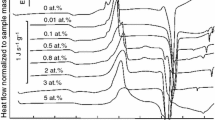Abstract
Method of preparation of bulk glassy samples in the GeS (x=1–2) system by cooling (quenching) from the melt in water (with the rate of cooling of the order of 102 °C/sec) is described. Initial substances were of 6–7N purity. Characteristic temperatures of phase transitionsT g (glass transition),T k (crystallization) andT m (melting) were determined using DTA. Glass-forming tendency was evaluated by means of the relationT k —T g/Tm —T k that was previously proposed by the author. It is found that glass can formed for compositions from GeS1.1 upwards, the minimum in the glass-forming tendency being in the vicinity of GeS1.0. Glasses in the whole range of compositions investigated consist of several phases, in accordance with the equilibrium diagram of Ge-S alloys. It is suggested to divide these glasses into three groups:
-
1.
GeS-GeS1.12, which are formed hardly, are composed prevalently from GeS and small quantities of GeS2 and G,
-
2.
GeS1.12-GeS2, which are formed more easily, are composed from GeS and GeS2 (increasing GeS2 content),
-
3.
from GeS2 upwards, which are formed very easily, are composed from GeS2 and sulphur.
Similar content being viewed by others
References
Kawamoto Y., Tchuschihashi S., J. Amer. Cer. Soc.54, No 3 (1971), 131.
Hrubý A., Czech. J. Phys.B 22 (1972), 1187.
Hrubý A., Štourač L., Mat. Res. Bull.6 (1971), 456.
Hrubý A., Štourač L., Mat. Res. Bull.6 (1971), 247.
Hrubý A.,Bor P., Research Report Inst. Solid State Physics, No 644 (1972).
Borshevski A. S., Roenkov N. D., Z. Neorg. Chim.8 (1969), 2253.
Matyáš M., private communication.
Liu-Chü'n-Hua, Pashinkin A. S., Novoselova A. V., Dokl. A. N. USSR,151, No 6 (1963), 1335.
Viaene W., Moh H., Neues Jahrb. Miner. Monatbl.6 (1970), 283.
Ross L., Bourgon M., Canad. J. Chem.46 (1968), 2464.
Trousil Z., Pajasová L., Závětová M., Czech. J. Phys.B 21 (1971), 220.
Spandau H., Klanberg F., Z. f. Anorg. Allg. Chem.295 (1958), 291.
Kawamoto Y., Tschuchihaschi S., J. Amer. Cer. Soc.54, No 10 (1971), 527.
Author information
Authors and Affiliations
Rights and permissions
About this article
Cite this article
Hrubý, A. Glass-forming tendency in the GeSx system. Czech J Phys 23, 1263–1272 (1973). https://doi.org/10.1007/BF01591209
Received:
Issue Date:
DOI: https://doi.org/10.1007/BF01591209




